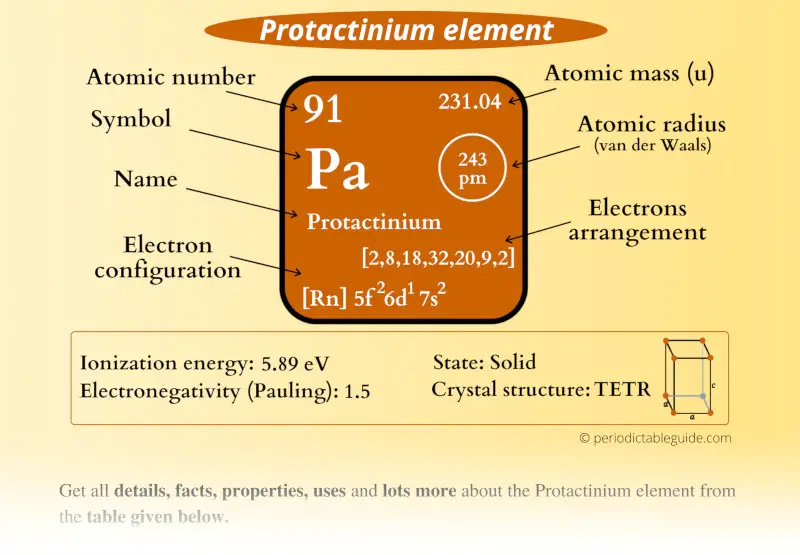
This is a SUPER easy guide on Protactinium element.
In fact, the table mentioned below is the perfect information box (Which gives you every single detail about the Protactinium element in Periodic table.)
So if you want to know anything about Protactinium element, then this guide is for you.
Let’s finish this very quickly.
Protactinium Element (Pa) Information
| Appearance | Silvery-white metallic luster |
| State (at STP) | Solid |
| Position in Periodic table | 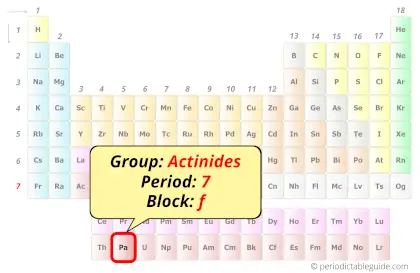 Group: actinides, Period: 7, Block: f |
| Category | 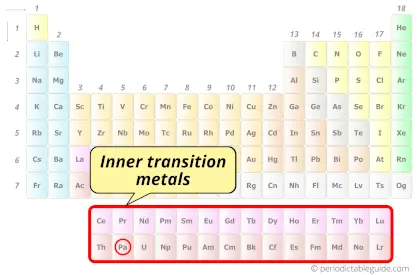 Inner transition metals |
| Atomic number or Protons | 91 |
| Neutrons | 148 |
| Electrons | 91 |
| Symbol | Pa |
| Atomic mass | 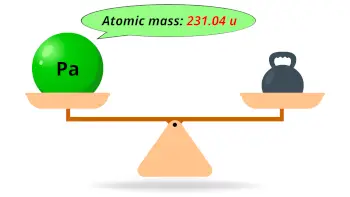 231.04 u |
| Electrons arrangement or Bohr model | 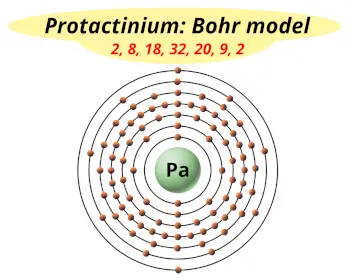 2, 8, 18, 32, 20, 9, 2 |
| Electronic configuration | [Rn] 5f2 6d1 7s2 |
| Atomic radius | 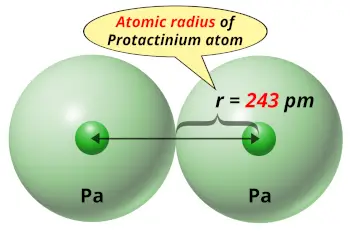 243 picometers (van der Waals radius) |
| 1st Ionization energy | 5.89 eV |
| Electronegativity | 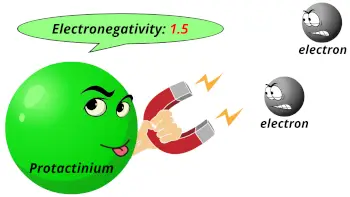 1.5 (Pauling scale) |
| Crystal structure | 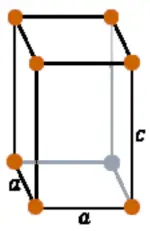 Tetragonal |
| Melting point | 1841 K or 1568 °C or 2854 °F |
| Boiling point | 4300 K or 4027 °C or 7280 °F |
| Density | 15.37 g/cm3 |
| Main isotope | 231Pa |
| Who discovered Protactinium and when? |  Kasimir Fajans (in 1913) |
| CAS number | 7440-13-3 |
Protactinium in Periodic table
Protactinium element is in period 7 and in actinides group of the Periodic table. Protactinium is the f-block element and it belongs to inner transition metals group.
| H | He | ||||||||||||||||
| Li | Be | B | C | N | O | F | Ne | ||||||||||
| Na | Mg | Al | Si | P | S | Cl | Ar | ||||||||||
| K | Ca | Sc | Ti | V | Cr | Mn | Fe | Co | Ni | Cu | Zn | Ga | Ge | As | Se | Br | Kr |
| Rb | Sr | Y | Zr | Nb | Mo | Tc | Ru | Rh | Pd | Ag | Cd | In | Sn | Sb | Te | I | Xe |
| Cs | Ba | La* | Hf | Ta | W | Re | Os | Ir | Pt | Au | Hg | Tl | Pb | Bi | Po | At | Rn |
| Fr | Ra | Ac** | Rf | Db | Sg | Bh | Hs | Mt | Ds | Rg | Cn | Nh | Fl | Mc | Lv | Ts | Og |
| *Ce | Pr | Nd | Pm | Sm | Eu | Gd | Tb | Dy | Ho | Er | Tm | Yb | Lu | ||||
| **Th | Pa | U | Np | Pu | Am | Cm | Bk | Cf | Es | Fm | Md | No | Lr |
←Move to: Thorium (Th) element – Periodic Table
→Move to: Uranium (U) element – Periodic Table
Why is Protactinium in Period 7?
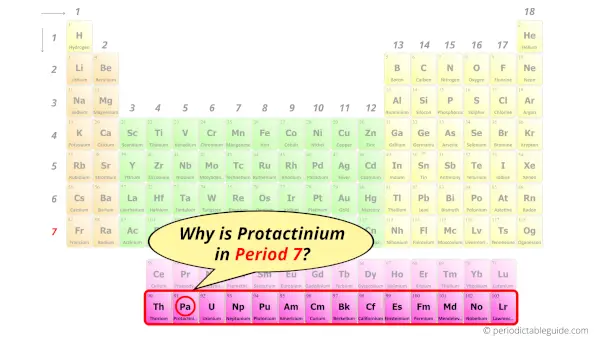
Let me ask you a question.
How many shells does protactinium have?
It’s 7. Right?
You have already seen the bohr model of protactinium atom in the above table.
From the Bohr model, it can be found that the number of orbits or shells in protactinium is 7. Hence, as protactinium has 7 orbits, it lies in period 7 of the Periodic table.
Why is Protactinium in f-block?
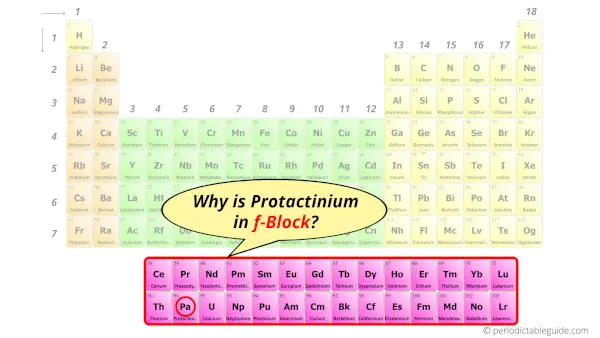
Before knowing this reason, first of all I want to ask you a simple question.
How can you determine the blocks-wise position of elements?
The simple answer: The elements will lie in the s, p, d or f block will completely depend upon the subshell in which the last electron will enter.
For example; the electron configuration of protactinium is [Rn] 5f2 6d1 7s2.
So the last electron of protactinium enters the f-subshell or f-orbital.
Hence, protactinium is the f-block element.
5 Interesting facts about Protactinium
Interesting facts about protactinium element are mentioned below.
- The name “Protactinium” was derived from the Greek word “protos” (which means first) and “actinium”.
- Protactinium element is present in very rare quantities in the earth’s crust and its concentration in earth’s crust is 0.1 parts per trillion only.
- Naturally occurring protactinium is obtained from uranium ores and its proportion in uranium ores is around 3 ppm.
- The largest amount of protactinium obtained till today is only 125 grams. This was extracted by the Great Britain Atomic Energy Authority from approximately 60 tonnes of nuclear waste. [1]
- Apart from being radioactive, it is also a toxic metal.
Properties of Protactinium
The physical and chemical properties of protactinium element are mentioned below.
Physical properties of Protactinium
Physical properties of protactinium are mentioned below.
- Protactinium is a dense metal having silvery-white metallic lustre.
- Protactinium has around 29 isotopes and all of those isotopes are radioactive in nature.
- The crystal structure of protactinium is tetragonal.
- The atomic mass of protactinium is 231.04 u and its density is 15.37 g/cm3.
- The melting point of protactinium is 1568 °C and its boiling point is 4027 °C.
Chemical properties of Protactinium
Chemical properties of protactinium are mentioned below.
- Protactinium is a radioactive element and dangerous to humans as well as animals.
- In compound forms, the most common oxidation state of protactinium is +5. But apart from this, it also exists in other oxidation states like +2, +3 and +4.
- Protactinium reacts with water vapor, oxygen as well as acids, but it does not react with alkalis.
Uses of Protactinium
Protactinium is generally used for research work in chemistry. Protactinium has no commercial uses due to its radioactive nature and scarcity.
Explore our New Interactive Periodic Table (with Rotating Bohr Models and More)

Details about this Periodic table:
- Access detailed info on all elements: atomic mass, electron configurations, charges, and more.
- View rotating Bohr models for all 118 elements.
- Get a free HD image of the Periodic Table.
Note: For future use, bookmark this Periodic table or visit “PeriodicTableGuide.com”
External resources:
- Protactinium – Element information, properties and uses | Periodic Table. (n.d.). Protactinium – Element Information, Properties and Uses | Periodic Table. https://www.rsc.org/periodic-table/element/91/protactinium
- Protactinium – Wikipedia. (2019, January 9). Protactinium – Wikipedia. https://en.wikipedia.org/wiki/Protactinium
- P. (n.d.). Protactinium | Pa (Element) – PubChem. Protactinium | Pa (Element) – PubChem. https://pubchem.ncbi.nlm.nih.gov/element/Protactinium
- It’s Elemental – The Element Protactinium. (n.d.). It’s Elemental – the Element Protactinium. https://education.jlab.org/itselemental/ele091.html
- Scerri, E. (2013, July 18). Element 91—Protactinium. A Tale of Seven Elements. https://doi.org/10.1093/oso/9780195391312.003.0008
- C&EN: IT’S ELEMENTAL: THE PERIODIC TABLE – PROTACTINIUM. (n.d.). C&EN: IT’S ELEMENTAL: THE PERIODIC TABLE – PROTACTINIUM. https://pubsapp.acs.org/cen/80th/protactinium.html?
